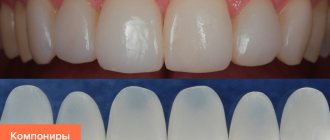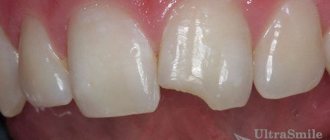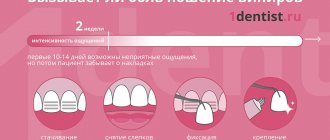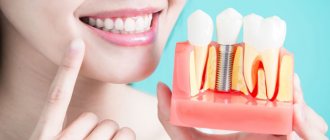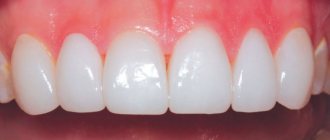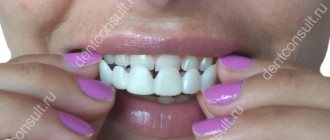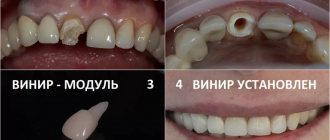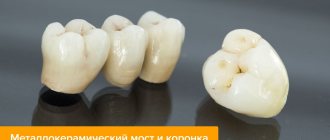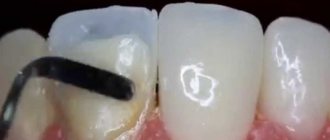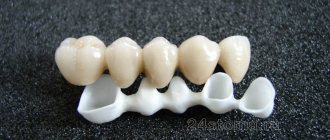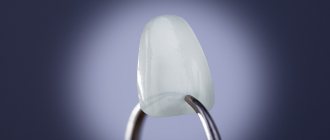Porcelain veneers
Porcelain plates are visually indistinguishable from the enamel of a normal tooth. Therefore, ordinary people will never guess about the installed records.
The advantages of ceramic crowns are that they are resistant to stress and practically do not stain.
Porcelain microprostheses are made using two methods:
1. Pressed ceramics - the material is applied in layers, then each layer is fired. In this case, the teeth are not ground down.
2. Pressed material – ceramic material is pressed under pressure and then fired at high temperatures. This method is used to achieve the strongest possible structure.
How to make porcelain veneers is decided by the doctor, based on the individual characteristics of the patient.
Plus, the service life of ceramic restorations is more than 20 years. If you decide to put veneers or crowns on your teeth, follow hygiene procedures.
E-max ceramic veneers and zirconium dioxide
Metal-free veneers contain a frame made of lithium disilicate or zirconium dioxide. Such plates are almost transparent and have a fine structure. And unlike others, their service life increases to 25–30 years.
Pros of ceramic zirconium veneers
• Duration of operation is longer than that of porcelain;
• Lithium disilicate plates look natural, regardless of lighting;
• Color does not change after eating food coloring;
• Do not accumulate plaque if the rules of oral hygiene are ignored;
• Does not have a black coating when smoking;
• They are light in weight and thin, so wear off of the enamel is minimal.
Zirconium veneers, unlike composite plates, are placed on teeth, even in the most difficult clinical cases. Usually, they are inserted in the smile zone - on the 10 upper and 8 lower teeth.
The downside is that the insertion process takes longer due to the fact that the material is difficult to fix on the tooth surface.
Installation requires minor tooth grinding.
Advantages
The use of this material has a number of advantages, which include the following positive qualities:
- the use of onlay plates ensures a natural appearance of the dentition;
- with proper care, they do not lose their color and shape for more than 10 years;
- are resistant to pigmentation when eating food with a coloring effect;
- the material does not become an allergen for the patient;
- have stability when eating dishes with different temperatures;
- due to the tight fit to the surface enamel, it minimizes the chance of developing carious cavities;
- have increased hardness, which prevents breakage during chewing;
- preserve the natural whiteness and appearance of the dentition in any type of lighting;
Due to their small mass, the devices do not feel like a foreign object in the mouth.
Main characteristics of dental ceramics and its purpose.
Visit here to learn more about feldspathic veneers.
At this address https://www.vash-dentist.ru/protezirovanie/nesemnyie-p/lyuminiryi/lyuks-bezuprechnaya-ulyibka.html we will discuss the price of installing luxniers.
Composite veneers (componeers)
They are made from filling material in two ways and differ in how veneers are placed on the teeth:
1. Aesthetic filling (therapeutic) - installation occurs in one stage. Specialist. Using equipment, the doctor polishes the front side of the tooth. Then filling material is applied to this plane. Apply as thin a layer as possible. This method can hide only minor aesthetic problems.
2. Production of composite plates in a dental laboratory using special impressions. Before installing veneers on the front teeth, the dentist grinds down the enamel. The process requires several steps, so the implants are fixed at subsequent appointments.
The downside is that the service life of composite veneers is 5 years. A significant disadvantage is also a change in the color of the plates - darkening of the cladding.
Contraindications
The doctor will refuse to install veneers in the following cases:
- Complete destruction of the front teeth. In this case, there is no base on which to attach the veneers.
- Gum diseases in chronic or acute form. Bleeding and swelling of the gums are a complete contraindication for the installation of structures.
- A small crown or insufficient base on which it is difficult to fix the onlay.
- Bruxism disease.
- Excessive curvature of teeth, which can only be corrected through surgery.
- Direct bite.
- Absence of the seventh and sixth teeth.
If you refuse to install veneers, the dentist will recommend another type of prosthetics.
Indications for installation of veneers
1. People who were unable to achieve the desired teeth color.
2. Darkening of the tooth enamel occurred due to a filling made with formaldehyde paste, or when a nerve was removed.
3. Old fillings that have changed their color and differ from tooth enamel.
4. They are given to people who have diastemas, trema, and chips.
5. When the teeth have an irregular anatomical shape (wedge-shaped).
6. The patient has diseases - this could be enamel erosion, necrosis, hypoplasia, etc.
Possible alternatives
If for some reason it is not possible to install zirconium dioxide veneers, then methods using other dental materials are used.
In such cases, composite materials or ceramics are recommended for the manufacture of dental onlays. In some cases, prosthetics are used using overlay plates in the form of lumineers, or zirconium crowns are installed.
Composite
This is a type of filling material. The production of overlay plates can occur using two methods.
In the first case, the installation of a composite onlay is performed directly in the dental office without first making impressions. The big advantage is that the crown part of the tooth is corrected only in the right places.
The second option, using a composite, involves making an impression with the subsequent formation of a future onlay. This process is performed by a dental technician in a laboratory setting.
Separately, it is necessary to highlight the photopolymer material for the manufacture of veneers. It hardens under the influence of a light wave of a certain length. It is applied layer by layer to the treated surface. With the help of this type of orthopedic product, a high level of aesthetic value is achieved.
Porcelain
This type of product does not exceed 0.5 mm in thickness. Compared to other types of composite materials, it has better characteristics, which makes it possible to give natural whiteness to the dentition.
Over time, this type of veneers does not fade and retains its color, even if foods and drinks are consumed that can cause pigmentation (tea, coffee, tomatoes and various sauces).
But compared to zirconium products, ceramics is a more fragile material.
Methods for manufacturing ceramic microprostheses.
| Serial number | Manufacturing method | Short description |
| 1 | Application of pressed ceramics | Initially, wax modeling is performed, after which the ceramic plate is pressed under high pressure. With this technique, the inside of the onlay completely conforms to the surface of the tooth, which subsequently ensures a tight fixation of the veneers. |
| 2 | Layer-by-layer application | The ceramic mass is applied layer by layer onto a special stump made of fire-resistant material. The finished product is fired in a special furnace, acquiring the necessary strength parameters. |
Lumineers
The advantage of installing lumineers is that there is no need to grind down teeth.
The process of placement in the oral cavity occurs in a minimum time of 2 or 3 visits. But the high cost limits the scope of application of this type of prosthetics.
Crowns
Covering the dental unit on all sides is the main difference between a crown and an onlay plate.
In addition, it ensures the restoration of chewing function, even when the tooth has significant damage and loses its functionality as a result of the appearance of carious cavities, cracks and chips.
The advantages of installing zirconium crowns include their ability to eliminate defects such as large gaps between teeth, restore the natural color of surface enamel, and solve problems of abnormal bite (with minor curvature).
Who are veneers contraindicated for?
People who have the following diseases and problems are not recommended to get implants.
• The presence of a dental anomaly “bruxism” is a forceful clenching of the jaws during sleep.
• Insufficient amount of tooth enamel.
• Bite pathology, meaning straight, deep bite.
• Caries and its complications.
• A group of diseases that are characterized by inflammatory processes - gingivitis, periodontal disease, etc. These diseases are a temporary contraindication. After treatment, the structures are successfully installed.
• Severe tooth fragility, or the presence of a bulky filling.
Veneers and Lumineers, and how they differ
Lumineers are crowns made from special dental porcelain.
Lumineers are produced by the American company, which has developed and patented the specific composition of dental porcelain and production technology. This company produces lumineers in California. Therefore, the production of such micro prostheses takes about 30 days.
The word lumineers comes from the Latin word “lumen”, which literally means “light”. The creators of lumineers claim that your teeth will become much whiter. This means that the client will receive a “Hollywood smile”. However, veneers are not much inferior to lumineers. The latter can be distinguished rather by their “luminous effect”, but otherwise they are simply an analogue of ceramic veneers.
A significant advantage of lumineers is the thickness of the plate. It is: 0.2 - 0.3 mm, and the thickness of the veneers: from 0.2 mm. up to 0.8 mm., therefore, lumineers are installed without preliminary turning, just like veneers. The impression is made directly from the tooth.
Preparatory process
1. Hygienic teeth cleaning, plaque removal.
2. Grind down a thin layer of enamel, from 0.5 to 0.7 mm.
3. A harmonious shade is selected.
4. The remaining enamel is coated with a special acid.
5. An impression is made.
6. The tooth plate is carefully polished and onlays are inserted.
A thin layer of enamel is ground off in order to achieve the most harmonious and natural look. They also grind it in order to insert and firmly strengthen the plate.
The process of installing permanent veneers
Permanent microprostheses are placed at the second appointment. First, the orthopedist visually assesses how suitable the finished model is:
- According to the form;
— By color;
- According to the tightness of fit to the surface of the tooth.
When the dentist is convinced that the characteristics are correct, the onlays are installed.
1. The finished structure is fitted.
2. Then they control the accuracy and tightness of the fit.
3. The procedure is completed with fixation of microprostheses.
Negative sides
The disadvantages of the products include:
- High price.
- Long production time.
- Difficulty in manufacturing due to the need for high precision and the difficulty of fixing the material to the dental organ.
- The need for expensive equipment for the manufacture of structures.
- The need to grind the tooth before installing a microprosthesis.
- Possibility of breakage or peeling if the products are not properly cared for. After peeling off, the veneer can be reinstalled, but if it breaks, it will be necessary to make a new one.
- Once the products have been installed, the teeth will no longer be able to regain their original appearance.
Is it possible to get veneers without grinding teeth?
In order to avoid grinding down the enamel, veneers made from feldspar and E-max should be inserted; they are thinner and do not require such a procedure.
It is possible to refuse turning if:
1. You have uneven teeth;
2. If the teeth are heavily worn;
3. It is necessary to change the direction of a crooked tooth;
4. It is necessary to add volume to the tooth.
There are no ideal teeth, so veneers without grinding cannot yet be placed. Except if the teeth are sparse and not voluminous. Grinded teeth can no longer be restored in the future, so you will always need to install crowns or their equivalents.
Price
The cost of microprostheses will be influenced by the following factors:
- prestige of the dental clinic;
- region and city of Russia;
- skills and qualifications of a specialist.
Any medical institution that has the appropriate equipment for making zirconium veneers, the price includes all manipulations, from the initial examination to fitting and installation of the overlay plate.
The average price for one unit can range from 20 to 50,000 rubles. But installing one overlay is done in rare cases. To restore a snow-white smile, it is planned to replace several frontal incisors with prosthetics .
In this case, the average cost will be:
- restoring the smile zone using 12 overlays will cost 250,000 rubles;
- a segment of 4 pieces will cost 90,000;
- within 130,000 rubles. is the price of a segment of 6 units.
Zirconium veneers are a dental innovation, which explains their high cost. Financial difficulties are the main obstacle to the availability of prosthetic procedures using this method.
Also, they have not yet received sufficient distribution due to the fact that not every clinic is equipped with equipment for their production. The video shows the result of closing the gap between teeth with zirconium veneers.
What happens to the teeth under the structure?
When the stitching is carried out correctly, and the design of the micro prosthesis is installed correctly, then nothing happens. However, if a plate, for example a composite, is not fixed tightly, caries or plaque accumulation may appear in such areas.
In case of plate defects, it is necessary to restore the micro prosthesis.
The downside is that it is impossible to remove the veneers; only the structure is replaced.
Most dentists provide a one-year warranty after installing the onlays.
